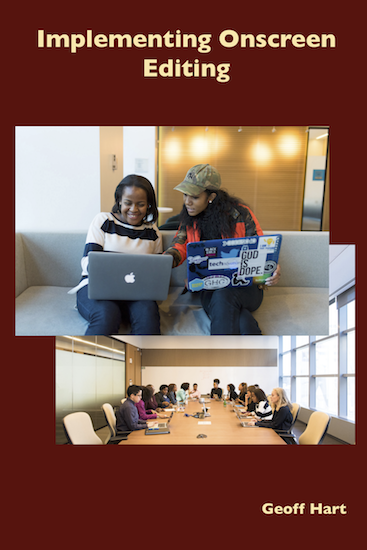
This page contains the following information:
|
–Geoff-Hart.com: Editing, Writing, and Translation —Home —Services —Books —Articles —Resources —Fiction —Contact me —Français |
You are here: Books --> Implementing onscreen editing
Vous êtes ici : Livres --> Implementing onscreen editing
(Now available!)
Effective Onscreen Editing teaches the essential skills for editors, but if you need to implement onscreen editing across an organization, or improve an existing system, you'll need Implementing Onscreen Editing.
Bibliographic information: Hart, G. 2019. Implementing onscreen editing. Diaskeuasis Publishing, Pointe-Claire, Quebec.
 |
This page contains the following information: |
Most editors don't need to be convinced of the advantages of onscreen editing. (If you do, or must persuade someone, please see Why edit on the screen? Advantages of onscreen editing.) But it can be a challenge convincing managers to modify an existing writing, review, and revision process. Many human, organizational, and technological factors can make change difficult. Based on my nearly 30 years of experience as an editor and as a mentor for other editors, and my participation in two successful implementation processes in a Canadian federal government publication department and a nonprofit research institute, Implementing Onscreen Editing will help you build a strong case for change and ease your organization's transition to the new system.
If you want to purchase multiple copies of Effective Onscreen Editing or Implementing Onscreen Editing to support training or implementation of a new process, please contact me to ask about volume discounts.
The most practical (and least intimidating) option is to use the book to develop a proposal for how you plan to implement onscreen editing, or improve an existing review and revision process. You can then discuss that proposal with the managers who must approve your proposal before you can begin.
To use the PDF version of the book most effectively: Using Ebooks in PDF format. (I've included an EPUB version as a lagniappe. My apologies for the low quality; it would take far too long for me to fix it up to professional standards to justify the effort.)
Implementing Onscreen Editing has not yet been reviewed, but was reviewed as part of the 3rd edition of Effective Onscreeen Editing. You can read the reviews of that book here. If you'd like to review Implementing Onscreen Editing, ask your editor to contact me to request a copy.
Teachers Want to add the book to your course reading list? Please contact me to obtain a free evaluation copy of the eBook, or a reduced price on the printed edition. Students Because of the low cost of the book, I have not created special pricing. However, I'm happy to arrange a reduced price for bulk purchases. Please contact me to discuss details.
Everyone else: PDF and EPUB versions (eBook)
Purchase and download a copy using your PayPal account or most major credit cards.
Both PDF and EPUB versions are included in the price, with no DRM; install both versions on all of your computers and tablets with no hassle.
Printed version
Visit Lulu.com to purchase the printed version. Shipping is pricey, so consider placing a group order with friends or colleagues to reduce the per-book cost.
Buy in bulk Want to buy many copies for your group or your professional association? Please contact me so we can discuss a bulk discount.
Front matter
Dedication
Acknowledgments
A Word on Copyright
Preface: Why You Should Read This Book—And How
Chapter 1. An Implementation Framework
A Framework for Managing Change
Overview of the framework
Steps in the framework
Choice of factors to study
Data analysis and discussion
Helping People to Change
Identify the competing commitments
Challenge the assumptions
Take steps to change the behavior
What Comes Next?
Planning Points
Chapter 2. Overcoming Resistance to Onscreen Editing: Coping With the Human Factor
Fears
Unfamiliarity With the Available Tools
Blind Spots and the Status Quo
Facilitating the Dialogue
Planning Points
Chapter 3: Implementing the Theory: a Four-Step Process
Step 1. Get Permission to Try
Demonstrate the benefits
Eliminate or minimize bad consequences
Step 2. Develop a Test Case
Pick at least one suitable author–editor pair
Pick appropriate projects
Obtain good numbers
Support the author and editor
Provide adequate time
Step 3. Solve Anticipated Problems
Organizational and bureaucratic problems
Human problems
Technological problems
Software incompatibilities
Workflow
Fonts and special characters
Ergonomics
Step 4. Watch for Unanticipated Problems
Take steps to minimize incompatibilities
Adopt an effective workflow
Phase in the new process gradually
Create paper trails to spot problems
Provide ongoing support
Ensure that communication happens
Relax a Little!
Iterate in response to technological and social change
Planning Points
About the Author
Customized Seminars and Consulting
Bibliography
Appendix I: Software Considerations
A Warning About Macintosh Computers
Work With Your IT Group
Real-Time Interactions
Appendix II: Protecting Yourself From Injury While Using a Computer
Aches and Pains
Hand Problems
Eye Strain
Solutions
None yet. When I correct errors or add new information, I'll link to it under this heading.
©2004–2025 Geoffrey Hart. All rights reserved.